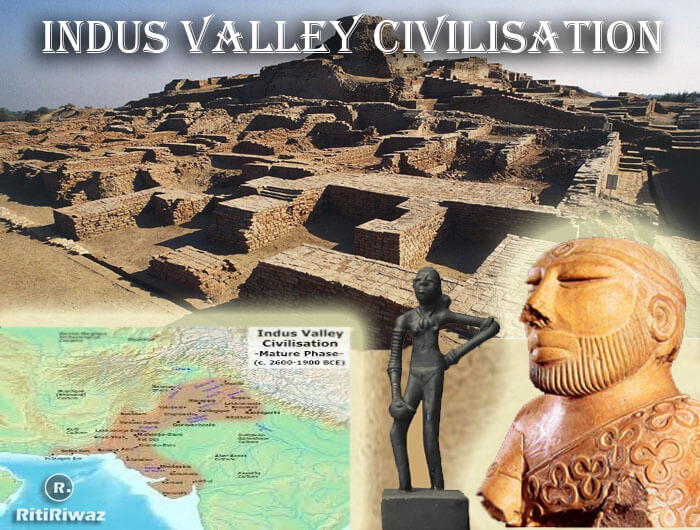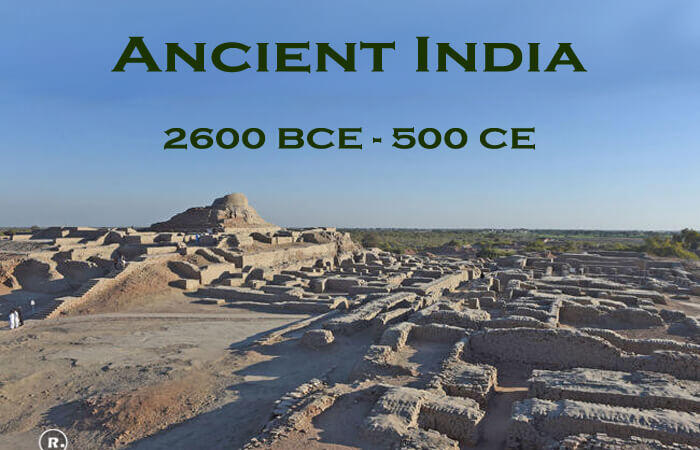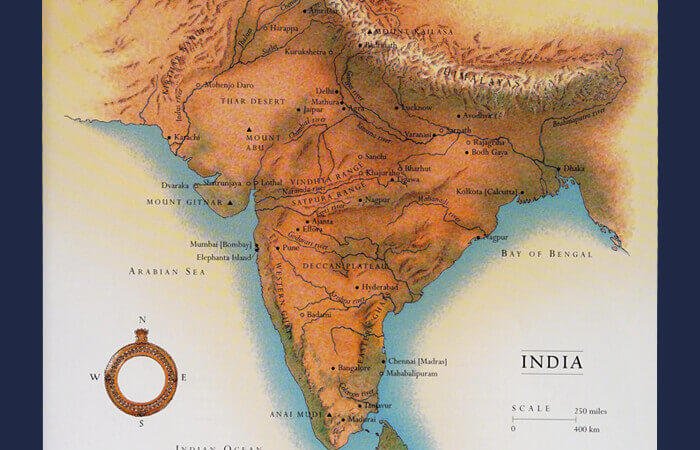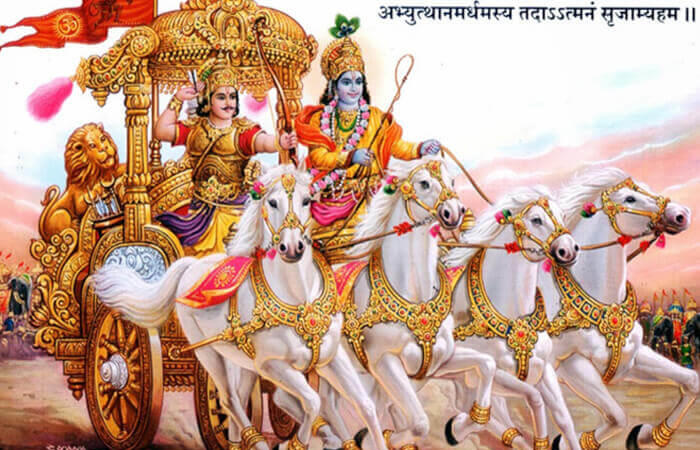Indus Valley Civilization (3300 BC to 1300 BC)

Indus Valley civilization was one the earliest cradle of human civilization of the world, the other two being ancient China and ancient Egypt civilization. It was also called the Harappan culture about 5000 years ago, and was famous for its systematic planning based on the grid system. The period, that started from 3300 BC in the region of what is today’s Pakistan and western India was one of the early major urban civilizations.
History
In history, there were four major civilizations namely –
- Mesopotamian
- Chinese,
- Egyptian
- Indus Valley Civilization
The Indus Valley Civilization is one of the oldest civilizations in human history. It arose on the Indian subcontinent nearly 5,000 years ago — roughly the same time as the emergence of ancient Egypt and nearly 1,000 years after the earliest Sumerian cities of Mesopotamia. The Indus Valley Civilization, in its mature phase, thrived for about 700 years, from around 2600 B.C. to 1900 B.C. Which, Indus Valley Civilization is the largest in largest in terms of its area(1,260,000 square kilometres). It was spread over India, Pakistan, Afghanistan etc. Current findings scientists show that the extent of the civilization was even bigger.
The civilization was spread around the Indus River. It runs in an area of 1.3 million square kilometers (500,000 square miles). It was home to about 1 to 5 million people. The civilization is famous for its large and well-planned cities. Over 1,052 cities and settlements have been found. Most of these are small, but amongst them are some of the largest cities of their time, especially Harappa and Mohenjo-daro.
The Indus Valley civilization covered most of what is today Pakistan and the Indian states of Gujarat, Rajasthan, Haryana, and Punjab Settlements that were closely related to the core civilization- and may have been colonies of it have been found in Afghanistan and central Asia. The huge Indus River system waters a rich agricultural landscape. The Indus Plain is surrounded by high mountains, desert, and ocean, and at that time there were dense forests and swamps to the east.
Indus Valley Civilization also created very large cities, carefully planned and laid out where almost every house had its bath and flush toilet, thousands of years before such things became common in other parts of the world. Somehow, the Harappans seem to have controlled this vast territory without having a large army or by conquering other weaker cultures, and they did not seem to have a single ruler such as a king or emperor. Then, for reasons that still aren’t understood, this culture declined and then vanished so completely that all that was left were piles of bricks in the plains of present-day India and Pakistan.
The Indus Valley Civilization, also sometimes known as the Harappan Civilization after the first archaeological site discovered there, became the fourth and most recently discovered of the ancient centers of civilization with the publication of the Mohenjo-Daro excavations in 1924.
Under the successive supervision of British archaeologists John Marshall, and then Mortimer Wheeler, large-scale archaeological excavations were carried out at Mohenjo-Daro and Harappa before the independence of India and Pakistan from Britain in 1947. Following independence, excavations by Indian, Pakistani, and international archaeologists continued, and they identified nearly 2800 sites related to the Indus Valley Civilization.
Indus Valley Civilization Facts
- The population of the Indus Valley Civilization was more than 5 million.
- It was John Marshell who excavated Harappa in 1920 and discovered that it was the first ever urban site.
- Mohenjadaro and Harappa are the capital cities of the Indus Valley Civilization.
- The Indus Valley Civilization is known as the Harappan civilization. The Harappa was the first site to be excavated in the early 20th century.
- The seven important cities of the Indus Valley Civilization were Mohenjodaro, Harappa, Kalibangan, Chanhudaro, Lothal, Banawali, and Dholavira.
- Sutkagendor, Balakot, Lothal, Allahdino, and Kuntasi are the port cities of Indus Valley Civilization.
- The Indus Valley Civilization was the largest among the four civilizations of the world, the other three being Mesopotamia, Egypt, and China.
- Many archeologists also call it the ‘Indus-Saraswati Civilization’ instead of the Indus Valley Civilization based on the two river systems while others call it the Harappan Civilization as Harappa was the first urban site to be discovered.
- The people of the Indus Valley civilization were hygienic. There were well-planned drainage systems, dustbins made of bricks, and a great bath.
- Most of the Indus Valley Civilization people were involved in artistic or trading activities. The economy of the Indus Valley civilization depended on trading. Their major business was import and export.
- Though there were no temples or priestly influence during the Indus Valley Civilization, archeologists have found evidence of worship of nature and animals. People used to worship ox and trees like peepal.
- The Great Bath (for ritual bathing), the Great Granary (for agricultural surplus), the Lothal Dockyard (for sea trade), and the Dholavira Reservoir (for irrigation) are some most important structures of the Indus Valley Civilization.
- The Mohenjodaro’s Great Bath was named the “first public water tank in the ancient world”, it was 39 feet long, 23 feet wide, and 8 feet deep.
- The smallest site in the Indus Valley Civilization was Allahdino.
- Mohenjodaro got the status of UNESCO World Heritage Site in 1980.
Art and Architecture
Arts: Artists of the Indus Valley civilization era had fine artistic sensibilities and a vivid imagination evident from the anatomical details included in the unique arts, their delineation of human and animal figures was highly realistic, and in the case of terracotta art, the modeling of animal figures was done with extreme care.
Architecture: The architecture of the Indus Valley Civilization was very unique. The architecture during this time was used for functions and not for beauty or decoration. The evolution of the architecture of civilization occurs in isolation. It has been influenced by the local cultures, which prevailed previously years back in the first farming and pastoralist settlements.
Characteristics of the Indus Valley Civilization
- Planned cities and towns with the basic layout of the citadel and lower town, Dholavira is exceptional as it has a middle town also. Use of the burnt bricks in the pre-Harappan phase.
- Water supply system and elaborate drainage system.
- Red Ware pottery painted with black designs, well fired, paintings consisting
of floral and geometric patterns and shapes including dish-on-stand, “S”
shaped jars, beakers, goblets, perforated jars etc., - Beads of Faience and steatite and long tubular beads of camelina,
- Terracotta Mother Goddess,
- Triangular Terracotta cakes and Mushtikas,
- Terracotta and Faience Bangles,
- Rohri chert blades,
- Seals and Sealings,
- Writing system/inscriptions,
- Chert and agate weights and
- Copper and Bronze objects.
Indus Valley Civilization Decline
The causes of the decline of the Indus Valley Civilization have not been firmly established. Archaeologists now believe that the civilization did not come to an abrupt end but gradually declined. People moved eastwards and cities were abandoned. Writing and trade declined.
Mortimer Wheeler suggested that the Aryan invasion led to the decline of the Indus Valley. Human bones discovered crowded together at Mohenjodaro further suggest that the city was attacked by strangers.
Robert Raikes suggests that tectonic movements and floods caused the decline.
Other causes cited include a drying up of the rivers, deforestation, and destruction of the green cover. It is possible that some cities were destroyed by floods but not all. It is now accepted that several factors could have led to the decline of the Indus Valley civilization.
New cities emerged only about 1400 years later.
Suggested Read: Brief Story Of India






